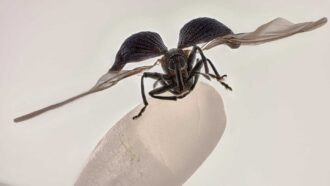Poisonous Spiders as Reluctant Hunters
The brown recluse spider prefers scavenging dead food to hunting live prey.
Share this:
- Share via email (Opens in new window) Email
- Click to share on Facebook (Opens in new window) Facebook
- Click to share on X (Opens in new window) X
- Click to share on Pinterest (Opens in new window) Pinterest
- Click to share on Reddit (Opens in new window) Reddit
- Share to Google Classroom (Opens in new window) Google Classroom
- Click to print (Opens in new window) Print
By Emily Sohn
New research suggests that brown recluses avoid living prey if they have the chance to scavenge for food that is already dead. This may be the first example showing a spider to prefer dead food to live prey.
Brown recluse spiders are infamous for their nasty bites, which can fester into painful, ugly sores. The spiders are about the size of a quarter. They live mostly in the southern and central parts of the United States.
Houses may have lots of brown recluse spiders. Spider expert Jamel Sandidge of the University of Kansas in Lawrence has caught as many as 1,400 brown recluses in a single house in just a 2-month period.
A little while ago, Sandidge heard that some exterminators tell people to kill all of the insects in their houses to starve and get rid of brown recluses. But Sandidge wasn’t sure that was good advice. He had seen the spiders feeding on insects that had been dead for weeks.
To test spider preferences, Sandidge brought 147 adult brown recluses to his lab. He put each one in an enclosure with a live insect and a dead one of the same species. He gave the spiders 5 minutes to pick a meal. More than 80 percent of the time, brown recluses chose the dead prey.
In other experiments, Sandidge saw spiders eat 1-month-old cockroach carcasses and crickets that had been dead for 2 weeks. He even saw brown recluses actually run away from live crickets.
Brown recluses are tough in other ways. Sandidge once gave a spider a cockroach that had been killed 10 months earlier by a common pesticide. The spider ate the cockroach but didn’t get sick itself.
If you feel sick at the thought of eating a rotting cockroach or a yellow mealworm larva, just think: If a brown recluse spider is eating dead bugs, at least it’s not hunting you!







